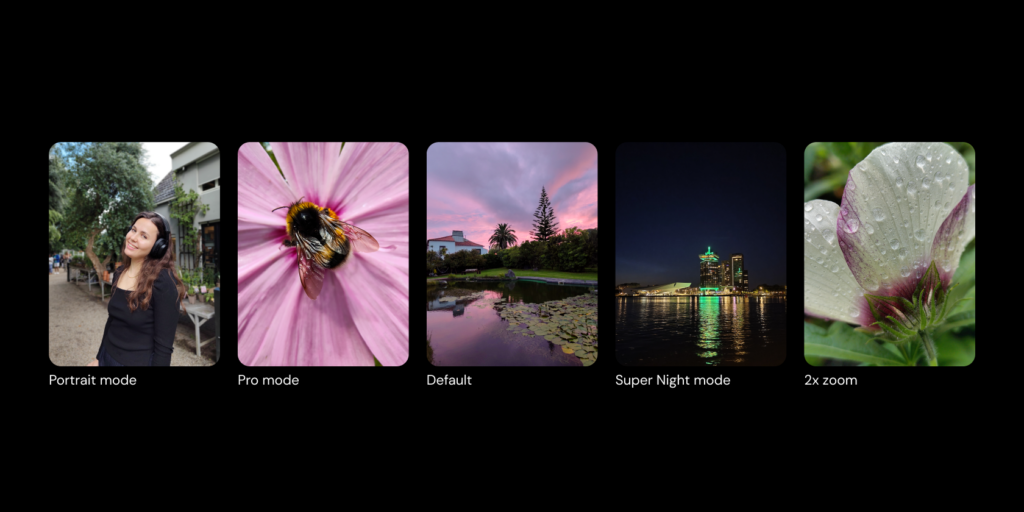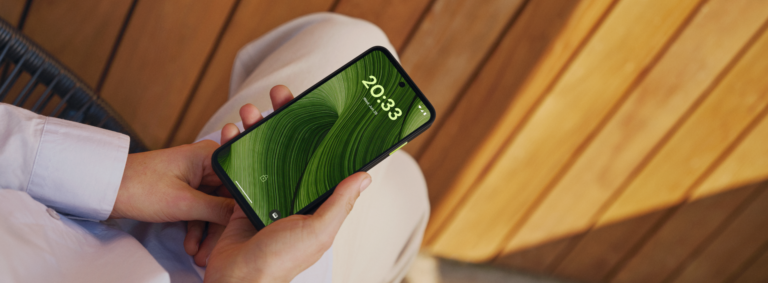Let’s talk about cameras on the new Fairphone (Gen. 6)
It’s 2025. Mobile phones have come a long way since the days of T9 and grainy, pixelated selfies that are in desperate need of photo sharpening. Your smartphone is only as good as the camera(s) on it. You can go full flagship and buy one that will shoot the moon for you. Or settle for something much, much more modest with a budget pick. We sat down with product manager, Javier Manrique, to really get to know the cameras on our latest generation, and why they are the best of both worlds.
The new Fairphone comes with a 50MP main camera, a 13MP ultrawide and a 32MP front camera. On paper, this seems like a step back compared to the three 50MP cameras on the Fairphone 5.
Sensor resolution is just one factor in creating good images. We also have to factor in other variables like the lens quality, sensor size, color tuning, dynamic range and more. And with mobile cameras, you also have to consider the processor that these cameras are matched to. Pricing the new Fairphone at a more affordable tag from the get-go was also important to us. With the new Fairphone, we finalized camera specs that were optimized for the Snapdragon 7s Gen 3, while also being mindful of budget. That’s why I don’t see them as a downgrade at all. The cameras we chose are the perfect combination of quality and affordability, and we have tuned them to the point of maximum efficiency. The pictures speak for themselves.
What’s the selection process like for the camera sensors?
Reverse engineering is key. We already knew what we wanted, and needed to find sensors and cameras that fit our requirements. It was an interesting proposition; better camera performance compared to the Fairphone 5, but at a lower price point. Keeping that in mind, we started benchmarking against the competition. The Sony Lytia 700c sensor had already proved its capabilities and fit perfectly with our requirements. With a larger sensor, it excels at low-light photography with high sensitivity and low noise. You can also shoot 4K videos at 60fps at frame rates and in HDR as well without draining your battery, thanks to its improved energy efficiency. Similarly, the Samsung KD1 sensor has become a go-to for other devices in the Fairphone’s price range, with standard features like autofocus and true-to-life color reproduction. At first glance, the ultrawide camera might be seen as specced lower, but it’s right up there with the competition. We worked really hard on tuning it just right to get it to deliver to its fullest potential.
Does Fairphone’s modular design approach influence which sensors and components we work with?
Not really. Almost all camera hardware out there can be adapted to fit our modular design. What does influence our choice of sensors and components is the sustainability credentials of the partners we work with. We don’t directly source components from Samsung and Sony. Instead, we work with manufacturers who put together the camera modules that go into our devices. It is their sustainability claims that we vet, from fair working conditions to using recycled materials to fairer supply chains.
Tell us more about the tuning process and what goes into it.
The tuning and software optimization decides things like color profiles, shutter lag and so on. The post-processing algorithms that we work with are trained partly on AI, but there is also a massive manual process, studying individual photographs to find the perfect color profile. We worked with TCL extensively, looking at over a thousand photographs to achieve true-to-life colors and specific tones for various scenes, especially sunsets and low-light shots. We really optimized it for everyday use, with a really balanced approach to color reproduction. Nothing is oversaturated, nothing is washed out either. We are also continually working to optimize it further. In mid-August, we will have an update to speed up shutter response for even more dynamic shots, even though shutter lag is not a priority for the rest of the industry anymore, especially with AI in the mix. If you really want to see the difference in what our tuning does, all you have to do is take the same shot in Auto mode and Pro mode.
Would you say Pro mode is still better for the camera enthusiast?
If you’re someone who takes photography seriously, you’ll want total control over the end image. The Pro mode on the new Fairphone does exactly that, going as close to a manual mode on a DSLR as possible. In Pro mode, you can capture images in RAW format, with the ability to adjust everything, from shutter speed to ISO to white balance. Of course, with this level of control, the potential for what you can achieve exponentially increases. The High Pixel mode on Fairphone 5 will be available as a setting within Pro mode as well, allowing you to capture images at the full 50MP resolution, especially for large-format printing and so on.
What about the other modes?
The Fairphone (Gen. 6) is perfect for anyone who want to shoot on the fly without worrying too much about the settings. We fine-tuned the cameras to do the heavy lifting when in auto mode. Blurriness and shakes are eliminated as much as possible. There’s the tried-and-tested Portrait mode, that really makes your subjects pop with a little bit of bokeh and depth of field tweaks. Super Night mode is really good for low-light shots; the images are adjusted for better contrast and minimal grain. For macro shots, you can try the Super Macro mode by hitting the flower icon on your camera UI, or switch to 2X zoom and go super close.
What’s the one thing you would have liked to add to the camera set-up?
Incorporating a telephoto lens would have been amazing, as it often requested by our community. Unfortunately, we would not have been able to do this without sacrificing battery space. If we ever make a smartphone in the future with a larger screen, we can consider a modular telephoto lens that could be swapped with the ultrawide lens. A telephoto lens takes a lot more space than the ultrawide.
What about the time-of-flight sensor? Is that something we could have sacrificed for a telephoto lens?
A lot of people ask us this question. The thing is that the slot that it sits in on the camera island is not large enough for a telephoto camera sensor. The ToF sensor itself is tiny. Like really, really tiny. It occupies significantly less space than a full camera sensor. It really helps too, especially with faster focusing and better bokeh effects.
And the ToF sensor is replaceable too, just like all the individual camera units.
That’s right. What really sets the Fairphone apart from the competition is not just the shooting experience. It’s the Fairphone’s modular design. That makes long-term maintenance of your device so much easier, with your pictures always looking their best for years to come. It’s the best smartphone we designed so far, with the best camera set-up as well.




